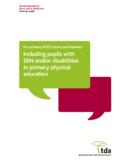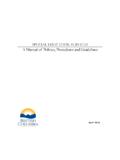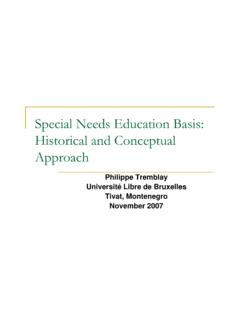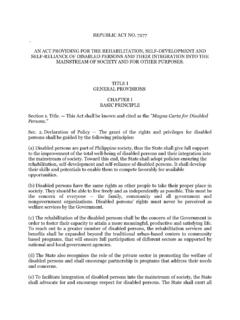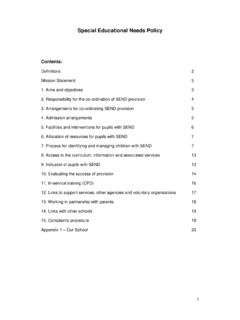Transcription of COVID-19 series: briefing on special educational needs and ...
1 COVID-19 series: briefing on special educational needs and disabilities provision, November 2020. Evidence from education, health and social care leaders and practitioners between 1. September and 4 December 2020. Ofsted has carried out a series of interim visits over the autumn term to gather information about how children's education and physical and emotional health have been supported during the pandemic. This briefing considers the experiences of children and young people with special educational needs and/or disabilities (SEND). gathered during Ofsted and Care Quality Commission (CQC)'s visits to education, health and social care providers. You can read more about the experience of pupils with SEND in mainstream primary and secondary schools in a separate briefing .
2 Data summary We used data from: six interim local area SEND visits in October 659 phone calls with early years providers between October and November 13 visits to residential special schools in September and October 45 visits to further education and skills (FES) providers in September and October 270 visits to schools between 10 and 19 November, including mainstream schools, special schools and pupil referral units (PRUs). a focus group with four social care inspectors, and written submissions from two social care inspectors. We also analysed written submissions from two social care inspectors who had completed visits to local areas and residential special schools. For most of the visits, inspectors collected information from leaders within the providers.
3 Practitioners and family members were only interviewed for interim area SEND visits. This briefing consequently mainly draws on the perspectives of leaders and practitioners, rather than of children and young people with SEND and their families. Published: December 2020. Main findings Children and young people with SEND were less likely to be attending their schools and colleges than their peers this term. This difference is not new. However, some children and young people with SEND have faced additional barriers to regular attendance as a result of the pandemic. These included: anxieties about the pandemic felt by parents and carers, and the children and young people themselves medical needs that required them to shield problems accessing transport.
4 Some children and young people who experienced prolonged absence from education were exposed to increased levels of abuse and neglect while at home or in care. When children are taken out of education, they are out of sight'. Some of these children have been living with domestic abuse, neglect and emotional abuse without practitioners being able to detect it. Even where children and young people with SEND are attending settings, most are not able to access the full curriculum. Barriers to a full curriculum include: part-time timetables a focus on core subjects difficulties with following COVID-19 (coronavirus) guidance in some subjects. These changes may mean that some children and young people with SEND are missing out on learning that is essential for their preparation for adult life.
5 Practitioners and leaders working with children and young people with SEND have found the pandemic personally and professionally difficult. Many individual practitioners have gone the extra mile' to provide support, sometimes to the detriment of their own health. However, some leaders and practitioners reported pulling together' as they met the challenges of the pandemic, which could result in better multi-agency working. Overarching questions This briefing examines the evidence about how the pandemic has affected children and young people with SEND in the following areas: 1. attendance 2. physical and emotional health 3. curriculum 4. practitioners and leaders' experiences COVID-19 thematic series: November briefing December 2020 2. Attendance Children and young people with SEND now face additional barriers to attending their education settings Children and young people with education, health and care plans (EHCPs) had lower levels of attendance in schools than all pupils this autumn.
6 Although some school leaders reported full attendance for pupils with SEND, national data published on 16. November 2020 stated that attendance in state schools was at 77% for pupils with EHCPs compared with 83% of all pupils. 1 In some cases, these children were only absent on certain days, but a small number of children had not returned to education. Levels of attendance have historically been lower for children and young people with EHCPs. However, they now face additional barriers that may be contributing to current levels of absence. One of the factors contributing to this was the acute anxiety of some parents and carers and, to a lesser degree, children and young people themselves. For example, one young person became afraid their residential setting had vanished during the first national lockdown.
7 Their key worker used video calls from within the school to reassure them. The young person returned to the setting, but they were still very afraid of people entering the building from outside. Children with respiratory conditions, profound and multiple learning difficulties or other long-term medical difficulties were also less likely to be attending. One special school leader reported that none of their pupils with these types of need had returned. Some of these children and young people remained at home because they were shielding in accordance with government guidance or because their families were anxious about clinically vulnerable children needing to avoid COVID-19 . Other barriers included government guidance continually changing and difficulties with specialist medical equipment being set up correctly at schools by health practitioners.
8 For example, a special school leader shared their frustration about certain equipment having to be set up by a physiotherapist and the fact that practitioners were not available to complete this task meant some children could not attend. Children attending special schools also faced difficulties with school transport. One special school leader said that taxis had not been easy to organise: We've put in our transport applications at the usual time and the Year 7. applications sat with [the local authority] and didn't get passed to transport, so we didn't have transport for new pupils.'. 1. Attendance in education and early years settings during the coronavirus ( COVID-19 ) outbreak', Department for Education, December 2020; statistics/attendance-in-education-and-e arly-years-settings-during-the-coronavir us- COVID-19 -outbreak.
9 COVID-19 thematic series: November briefing December 2020 3. School leaders also found managing bubbles for taxi and bus services difficult for the children and young people who were attending. This included services being unavailable at short notice due to driver illness. Good communication and frequent contact with families in the summer helped children and young people to return to education In order to ensure that children and young people resumed face-to-face learning, practitioners worked hard over the summer to build trusting relationships with families through regular contact. School leaders recognised the effectiveness of this in encouraging pupils to return to school at the start of the autumn term. For example, one mainstream school leader said it had led to a sea change' that resulted in a positive impact on attendance.
10 School leaders also felt their knowledge of pupils'. needs had improved due to these strong relationships. Better relationships between home and school had also gone some way towards mitigating families' anxiety about returning. One mainstream school leader commented that Parents were confident in us, so the pupils were as well'. Schools and colleges took other steps to build children and young people 's confidence about returning. Most colleges organised video tours of campus buildings that were sent to students with SEND in advance of the new term. One special school created personal transition documents for each pupil with information about their new classes and staff. Several mainstream schools anticipated that returning to education would be a particular challenge for children and young people with some types of SEND, such as autism or attention deficit hyperactivity disorder.










